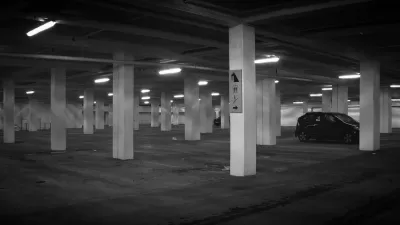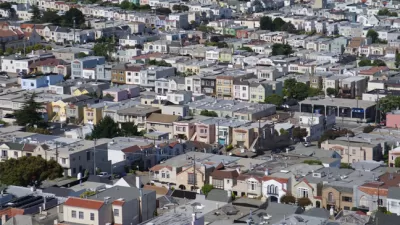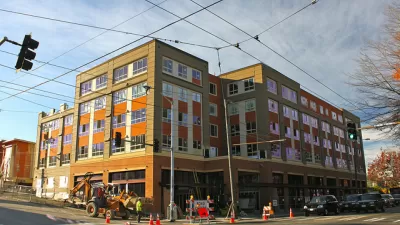Minimum parking requirements affect developer behavior most where they are most controversial: in downtown neighborhoods. In suburbs where they may just mimic the market, the arguments for such rules are paradoxically even weaker.

One common argument against the abolition of minimum parking requirements is that abolition would be futile: developers generally build as much parking as the law requires and then some.
A recent article in Access magazine by Cornell planning professor Michael Manville suggests otherwise. Manville studies the impact of Los Angeles’ "Adaptive Reuse Ordinance" (ARO), which provides that landowners who convert downtown commercial/industrial land to residential use need not build additional parking, even if city ordinances would otherwise require such parking.
Manville finds that the overwhelming majority of ARO landowners provided some parking: only 13 percent of ARO apartments, and 31 percent of condominium buildings, were completely parking-free. However, this statistic underestimates landowners’ use of the flexibility provided by the ordinance, since some of the buildings may have had preexisting parking.
In addition, ARO buildings typically provided less parking (or at least less on-site parking) than Los Angeles law requires for other buildings.For condos, Los Angeles typically requires two parking spaces per unit; however, the minimum ARO unit provided 1.3 spaces. ARO apartment units typically complied with the city’s one-space-per unit requirement; however, ARO apartment parking spaces, unlike most Los Angeles parking spaces, are often off-site. The typical ARO unit had only 0.6 parking spaces; thus, many landowners leased parking from nearby parking spaces, providing the developers with additional flexibility and reducing housing costs.
Manville points out that his findings are limited to downtowns, where parking may be more expensive and people are more willing to live car-free. By contrast, in low-density suburban areas where parking is cheap and driving is universal, developers may be more willing to build huge amounts of parking. Yet the latter areas are, it seems to me, the least willing to experiment with parking reform.
These conclusion, if true, suggests a paradox: minimum parking requirements are most popular precisely where they have the least impact. If suburban landowners will build more parking than the law requires, isn’t the law kind of pointless?
The traditional argument for minimum parking requirements is that they prevent people wasting fuel and time cruising for scarce parking spaces. But if suburban landowners will always build parking, there is no scarcity and hence no cruising.
A second argument for minimum parking requirements is that they prevent "spillover parking": that is, people parking in residential areas, inconveniencing residents who crave on-street parking spots. But this argument does not apply to many suburban areas because if parking is nearly always abundant, such spillover parking will never occur. Moreover, suburbanites are less likely to use parking than city drivers, because they usually park in their own driveways and garages.
So in car-oriented suburbs, minimum parking requirements may not do much harm- but they don’t do much good either.

Alabama: Trump Terminates Settlements for Black Communities Harmed By Raw Sewage
Trump deemed the landmark civil rights agreement “illegal DEI and environmental justice policy.”

Study: Maui’s Plan to Convert Vacation Rentals to Long-Term Housing Could Cause Nearly $1 Billion Economic Loss
The plan would reduce visitor accommodation by 25% resulting in 1,900 jobs lost.

Planetizen Federal Action Tracker
A weekly monitor of how Trump’s orders and actions are impacting planners and planning in America.

Waymo Gets Permission to Map SF’s Market Street
If allowed to operate on the traffic-restricted street, Waymo’s autonomous taxis would have a leg up over ride-hailing competitors — and counter the city’s efforts to grow bike and pedestrian on the thoroughfare.

Parklet Symposium Highlights the Success of Shared Spaces
Parklets got a boost during the Covid-19 pandemic, when the concept was translated to outdoor dining programs that offered restaurants a lifeline during the shutdown.

Federal Homelessness Agency Places Entire Staff on Leave
The U.S. Interagency Council on Homelessness is the only federal agency dedicated to preventing and ending homelessness.
Urban Design for Planners 1: Software Tools
This six-course series explores essential urban design concepts using open source software and equips planners with the tools they need to participate fully in the urban design process.
Planning for Universal Design
Learn the tools for implementing Universal Design in planning regulations.
Caltrans
Smith Gee Studio
Institute for Housing and Urban Development Studies (IHS)
City of Grandview
Harvard GSD Executive Education
Toledo-Lucas County Plan Commissions
Salt Lake City
NYU Wagner Graduate School of Public Service





























